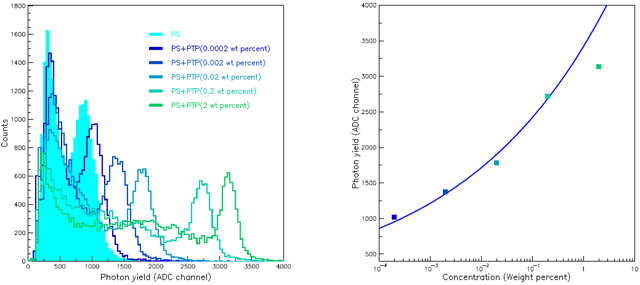December 28, 2012
A research team composed of the following members has observed, in polystyrene-based scintillation materials, photon amplification and emission that cannot be explained with the established scintillation mechanism: Assistant Professor Hidehito Nakamura (Visiting researcher of the National Institute of Radiological Sciences and Member of Chiba science city strategy expert committee) and Professor Sentaro Takahashi, Research Reactor Institute, Kyoto University; Chief researcher Yoshiyuki Shirakawa, and Researcher Hisashi Kitamura Research Development and Support Center, National Institute of Radiological Sciences; and Group leader Osamu Shinji and Group member Katashi Saito, Methacrylate development group, Niigata plant, Kuraray Co., Ltd. Photon yield from the polystyrene-based scintillation materials was found to increase in accordance with a power-law of concentration of fluorescent molecules doped in polystyrene.
The results of this research can have a variety of applications such as environmental background radiation / radiation measurements and elementary particle / atomic nucleus experiments, and it requires new interpretations of the scintillation mechanism in plastic scintillation materials, which are expected to have further applications in the future. It is also expected to help to develop high performance radiation detectors.
The results of this research were published in "Applied Physics Letters", the weekly journal of the American Institute of Physics, on December 28, 2012.
Background
Plastic scintillation materials made by doping fluorescent molecules to plastics have been used in a wide variety of applications in order to obtain high sensitivity in detecting radiation. The scintillation mechanism of these materials was established in the middle of 20th century and it is explained with the so-called "ladder", in which ultra violet light emitted from plastics by radiation is converted stepwise into visible light by fluorescent molecules. This means that fluorescent molecules whose absorption wavelength overlaps with the emission wavelengths of plastics are required in making plastic scintillation materials.
Methodology
In order to develop high performance plastic scintillation materials, the team focused on polystyrene, which emits ultra violet light when exposed to ionizing radiation. In a departure from the established prerequisites, para-terphenyl was used as fluorescent molecule despite the fact that its absorption wavelength has a small overlap with the emission wavelength of polystyrene.
In the established scintillation mechanism, light emitted from plastics should be absorbed by fluorescent molecules and the light should be attenuated every time when it is re-emitted. In addition, when the relation between emission wavelength of polystyrene and absorption wavelength para-terphenyl is taken into account, photon yield emitted from polystyrene-based scintillation materials should be smaller than photon yield emitted from polystyrene having no fluorescent molecules added.
However, the photon yield emitted from the polystyrene-based scintillation materials is found to be more than that from polystyrene having no fluorescent molecules added (see the figure on the left). In other words, the birth of new luminescence was shown. Furthermore, it is clearly shown (in the figure on the right) that photon yield from the scintillation material increases in accordance with a power-law of fluorescent molecule concentration (which is changed to the maximum of 5-orders). These phenomena cannot be explained with the present scintillation mechanism of plastic scintillation materials and requires new interpretations.

Figure: Measurement of Photon yield
In the figure, PS stands for polystyrene and PTP stands for para-terphenyl.
Ripple Effects
The product of this research will lead the way to the improved performance of radiation detectors which use a plastic scintillation material is used for such applications as natural environmental radiation / radiation measurements and elementary particle / atomic nucleus experiments.
This research was conducted with aid from the Kyoto University Research Reactor Institute and supported by the National Institute of Radiological Sciences, and Kuraray Co., Ltd.
Bibliography
[DOI] http://dx.doi.org/10.1063/1.4773298
"Development of polystyrene-based scintillation materials and its mechanisms", H. Nakamura, H. Kitamura, O. Shinji, K. Saito, Y. Shirakawa and S. Takahashi, Applied Physics Letters, 101, 261110 (2012).

